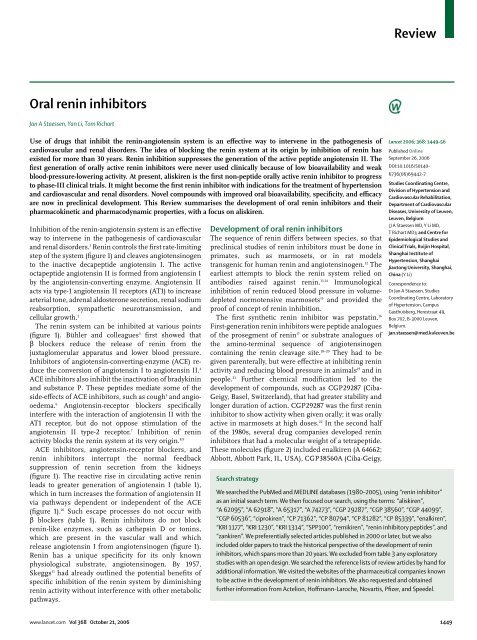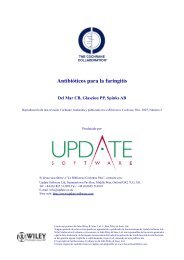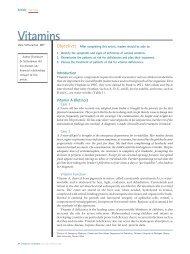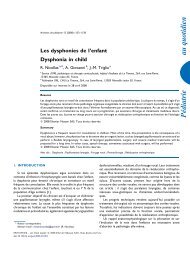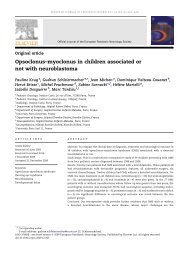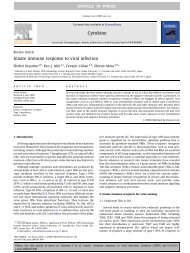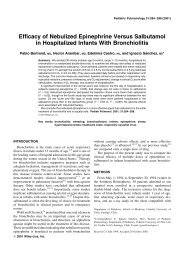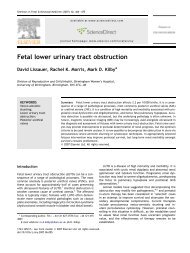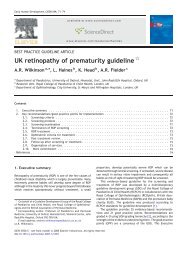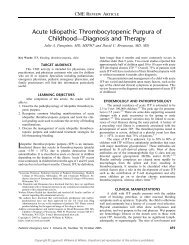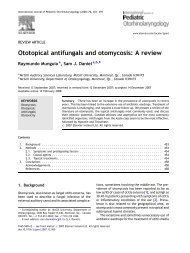Review Oral renin inhibitors - sepeap
Review Oral renin inhibitors - sepeap
Review Oral renin inhibitors - sepeap
You also want an ePaper? Increase the reach of your titles
YUMPU automatically turns print PDFs into web optimized ePapers that Google loves.
<strong>Review</strong><br />
<strong>Oral</strong> <strong>renin</strong> <strong>inhibitors</strong><br />
Jan A Staessen, Yan Li, Tom Richart<br />
Use of drugs that inhibit the <strong>renin</strong>-angiotensin system is an effective way to intervene in the pathogenesis of<br />
cardiovascular and renal disorders. The idea of blocking the <strong>renin</strong> system at its origin by inhibition of <strong>renin</strong> has<br />
existed for more than 30 years. Renin inhibition suppresses the generation of the active peptide angiotensin II. The<br />
first generation of orally active <strong>renin</strong> <strong>inhibitors</strong> were never used clinically because of low bioavailability and weak<br />
blood-pressure-lowering activity. At present, aliskiren is the first non-peptide orally active <strong>renin</strong> inhibitor to progress<br />
to phase-III clinical trials. It might become the first <strong>renin</strong> inhibitor with indications for the treatment of hypertension<br />
and cardiovascular and renal disorders. Novel compounds with improved oral bioavailability, specificity, and efficacy<br />
are now in preclinical development. This <strong>Review</strong> summarises the development of oral <strong>renin</strong> <strong>inhibitors</strong> and their<br />
pharmacokinetic and pharmacodynamic properties, with a focus on aliskiren.<br />
Inhibition of the <strong>renin</strong>-angiotensin system is an effective<br />
way to intervene in the pathogenesis of cardiovascular<br />
and renal disorders. 1 Renin controls the first rate-limiting<br />
step of the system (figure 1) and cleaves angiotensinogen<br />
to the inactive decapeptide angiotensin I. The active<br />
octapeptide angiotensin II is formed from angiotensin I<br />
by the angiotensin-converting enzyme. Angiotensin II<br />
acts via type-1 angiotensin II receptors (AT1) to increase<br />
arterial tone, adrenal aldosterone secretion, renal sodium<br />
reabsorption, sympathetic neurotransmission, and<br />
cellular growth. 2<br />
The <strong>renin</strong> system can be inhibited at various points<br />
(figure 1). Bühler and colleagues 3 first showed that<br />
β blockers reduce the release of <strong>renin</strong> from the<br />
juxtaglomerular apparatus and lower blood pressure.<br />
Inhibitors of angiotensin-converting-enzyme (ACE) reduce<br />
the conversion of angiotensin I to angiotensin II. 4<br />
ACE <strong>inhibitors</strong> also inhibit the inactivation of bradykinin<br />
and substance P. These peptides mediate some of the<br />
side-effects of ACE <strong>inhibitors</strong>, such as cough 5 and angiooedema.<br />
6 Angiotensin-receptor blockers specifically<br />
interfere with the interaction of angiotensin II with the<br />
AT1 receptor, but do not oppose stimulation of the<br />
angiotensin II type-2 receptor. 7 Inhibition of <strong>renin</strong><br />
activity blocks the <strong>renin</strong> system at its very origin. 8,9<br />
ACE <strong>inhibitors</strong>, angiotensin-receptor blockers, and<br />
<strong>renin</strong> <strong>inhibitors</strong> interrupt the normal feedback<br />
suppression of <strong>renin</strong> secretion from the kidneys<br />
(figure 1). The reactive rise in circulating active <strong>renin</strong><br />
leads to greater generation of angiotensin I (table 1),<br />
which in turn increases the formation of angiotensin II<br />
via pathways dependent or independent of the ACE<br />
(figure 1). 10 Such escape processes do not occur with<br />
β blockers (table 1). Renin <strong>inhibitors</strong> do not block<br />
<strong>renin</strong>-like enzymes, such as cathepsin D or tonins,<br />
which are present in the vascular wall and which<br />
release angiotensin I from angiotensinogen (figure 1).<br />
Renin has a unique specificity for its only known<br />
physiological substrate, angiotensinogen. By 1957,<br />
Skeggs 11 had already outlined the potential benefits of<br />
specific inhibition of the <strong>renin</strong> system by diminishing<br />
<strong>renin</strong> activity without interference with other metabolic<br />
path ways.<br />
Development of oral <strong>renin</strong> <strong>inhibitors</strong><br />
The sequence of <strong>renin</strong> differs between species, so that<br />
preclinical studies of <strong>renin</strong> <strong>inhibitors</strong> must be done in<br />
primates, such as marmosets, or in rat models<br />
transgenic for human <strong>renin</strong> and angiotensinogen. 12 The<br />
earliest attempts to block the <strong>renin</strong> system relied on<br />
antibodies raised against <strong>renin</strong>. 13,14 Immunological<br />
inhibition of <strong>renin</strong> reduced blood pressure in volumedepleted<br />
normotensive marmosets 15 and provided the<br />
proof of concept of <strong>renin</strong> inhibition.<br />
The first synthetic <strong>renin</strong> inhibitor was pepstatin. 16<br />
First-generation <strong>renin</strong> <strong>inhibitors</strong> were peptide analogues<br />
of the prosegment of <strong>renin</strong> 17 or substrate analogues of<br />
the amino-terminal sequence of angiotensinogen<br />
containing the <strong>renin</strong> cleavage site. 18–20 They had to be<br />
given parenterally, but were effective at inhibiting <strong>renin</strong><br />
activity and reducing blood pressure in animals 19 and in<br />
people. 21 Further chemical modification led to the<br />
development of compounds, such as CGP29287 (Ciba-<br />
Geigy, Basel, Switzerland), that had greater stability and<br />
longer duration of action. CGP29287 was the first <strong>renin</strong><br />
inhibitor to show activity when given orally; it was orally<br />
active in marmosets at high doses. 22 In the second half<br />
of the 1980s, several drug companies developed <strong>renin</strong><br />
<strong>inhibitors</strong> that had a molecular weight of a tetrapeptide.<br />
These molecules (figure 2) included enalkiren (A 64662;<br />
Abbott, Abbott Park, IL, USA), CGP38560A (Ciba-Geigy,<br />
Search strategy<br />
Lancet 2006; 368: 1449–56<br />
Published Online<br />
September 26, 2006<br />
DOI:10.1016/S0140-<br />
6736(06)69442-7<br />
Studies Coordinating Centre,<br />
Division of Hypertension and<br />
Cardiovascular Rehabilitation,<br />
Department of Cardiovascular<br />
Diseases, University of Leuven,<br />
Leuven, Belgium<br />
(J A Staessen MD, Y Li MD,<br />
T Richart MD); and Centre for<br />
Epidemiological Studies and<br />
Clinical Trials, Ruijin Hospital,<br />
Shanghai Institute of<br />
Hypertension, Shanghai<br />
Jiaotong University, Shanghai,<br />
China (Y Li)<br />
Correspondence to:<br />
Dr Jan A Staessen, Studies<br />
Coordinating Centre, Laboratory<br />
of Hypertension, Campus<br />
Gasthuisberg, Herestraat 49,<br />
Box 702, B-3000 Leuven,<br />
Belgium.<br />
jan.staessen@med.kuleuven.be<br />
We searched the PubMed and MEDLINE databases (1980–2005), using “<strong>renin</strong> inhibitor”<br />
as an initial search term. We then focused our search, using the terms: “aliskiren”,<br />
“A 62095”, “A 62918”, “A 65317”, “A 74273”, “CGP 29287”, “CGP 38560”, “CGP 44099”,<br />
“CGP 60536”, “ciprokiren”, “CP 71362”, “CP 80794”, “CP 81282”, “CP 85339”, “enalkiren”,<br />
“KRI 1177”, “KRI 1230”, “KRI 1314”, “SPP100”, “remikiren”, “<strong>renin</strong> inhibitory peptides”, and<br />
“zankiren”. We preferentially selected articles published in 2000 or later, but we also<br />
included older papers to track the historical perspective of the development of <strong>renin</strong><br />
<strong>inhibitors</strong>, which spans more than 20 years. We excluded from table 3 any exploratory<br />
studies with an open design. We searched the reference lists of review articles by hand for<br />
additional information. We visited the websites of the pharmaceutical companies known<br />
to be active in the development of <strong>renin</strong> <strong>inhibitors</strong>. We also requested and obtained<br />
further information from Actelion, Hoffmann-Laroche, Novartis, Pfizer, and Speedel.<br />
www.lancet.com Vol 368 October 21, 2006 1449
<strong>Review</strong><br />
Tissue RAS<br />
Kidney<br />
β blockers<br />
Renin<br />
Vasoconstriction<br />
Sodium retention<br />
Cellular growth<br />
Oxidative stress<br />
Renin<br />
<strong>inhibitors</strong><br />
Negative feedback via AT 1 -R<br />
ARB<br />
Chymase<br />
Angiotensinogen<br />
Cathepsin D<br />
Tonins<br />
Angiotensin I<br />
ACE ACE <strong>inhibitors</strong> ACE<br />
Angiotensin II<br />
EP<br />
ACE2<br />
Angiotensin (1-7)<br />
AT 1 -R AT 2 -R AT 1-7 -R AT 4 -R<br />
mas<br />
receptor<br />
Aldosterone<br />
Modulation of<br />
EC function<br />
Cough,<br />
angio-oedema<br />
Bradykinin<br />
Substance P<br />
Angiotensin (3-8)Inactive peptides<br />
Figure 1: The <strong>renin</strong>-angiotensin-aldosterone system<br />
Black arrows show stimulation and red arrows show inhibition. Dotted lines show alternative pathways mainly<br />
documented in experimental studies. β blockers, <strong>renin</strong> <strong>inhibitors</strong>, <strong>inhibitors</strong> of angiotensin-converting enzyme<br />
(ACE) and angiotensin II type-1 receptor blockers (ARB) reduce the activity of the <strong>renin</strong>-angiotensin system (RAS).<br />
AT-R=angiotensin receptor; EP=endopeptidases; EC=endothelial cells.<br />
Basel, Switzerland, [not shown in figure 2]), remikiren<br />
(Ro 425892; Hoffmann-La Roche, Basel, Switzerland),<br />
and zankiren (A 72517; Abbott). 9,23,24 When given orally,<br />
they had a bioavailability of less than 2%, a short halflife,<br />
and weak blood-pressure-lowering activity 9<br />
(table 2 25–29 ).<br />
By means of crystallography and computational<br />
molecular modelling starting from a corporate<br />
compound library, Hoffmann-La Roche subsequently<br />
developed and optimised substituted piperidine <strong>renin</strong><br />
<strong>inhibitors</strong>, which were abandoned after tests in<br />
preclinical studies. 30 At about the same time, Ciba-Geigy<br />
(now Novartis, Basel, Switzerland) discovered the orally<br />
active compound aliskiren (CGP 60536B, figure 2). 31<br />
However, the pathway for its synthesis, patented in<br />
1995, had many steps and was not suitable for industrial<br />
manufacture. In 1999, aliskiren was out-licensed to<br />
Speedel AG (Basel, Switzerland), who succeeded in<br />
designing a cost-effective method of production. 23,32<br />
After successful preclinical and clinical testing of<br />
aliskiren (SPP 100) by Speedel, Novartis exercised its<br />
call-back option for the further development of aliskiren<br />
in phase-III clinical trials. 33<br />
In 2001, Hoffmann-La Roche copied this strategy by<br />
out-licensing to Speedel a new subclass of <strong>renin</strong><br />
<strong>inhibitors</strong>, which are known as the SPP 600 series and<br />
are now under preclinical investigation. 23 In April, 2003,<br />
Speedel joined forces with Locus Pharmaceuticals (Blue<br />
Bell, PA, USA), who used their proprietary computational<br />
technologies to identify novel leads. In June, 2005,<br />
Speedel announced the discovery of new compounds<br />
(SSP 800 series), which have entered pharmacological<br />
profiling in animal models, with the goal of selecting a<br />
preclinical candidate in 2006.<br />
Studies of the first generation of oral <strong>renin</strong><br />
<strong>inhibitors</strong><br />
Haemodynamic and endocrine effects<br />
In normotensive primates 24,34–38 and human beings, 29,39–51<br />
<strong>renin</strong> <strong>inhibitors</strong> given intravenously or orally lead to<br />
acute and dose-dependent decreases in plasma <strong>renin</strong><br />
activity, plasma concentrations of angiotensin I and<br />
angiotensin II, (table 1) and blood pressure, without<br />
inducing reflex tachycardia.<br />
Table 3 summarises the effects of oral remikiren 28,41,43–48<br />
and zankiren 29,42 on blood pressure and plasma <strong>renin</strong><br />
activity in randomised clinical trials, excluding two<br />
exploratory studies with an open design. 26,52 In general,<br />
the blood-pressure-lowering activity has been small.<br />
Because normal feedback inhibition is interrupted by<br />
angiotensin II (table 1), <strong>renin</strong> inhibition consistently<br />
elicits a rise in circulating active <strong>renin</strong>. This escape<br />
process, which also occurs during treatment with ACE<br />
<strong>inhibitors</strong> and angiotensin-receptor blockers, explains<br />
why these three drug classes behave as incomplete<br />
Enzymes Substrates End-products<br />
PRA PRC Angiotensinogen Angiotensin I Bradykinin Angiotensin II Aldosterone<br />
β blockers ↓ ↓ NA NA NA NA NA<br />
Renin <strong>inhibitors</strong> ↓ ↑ NA ↓ NA ↓ ↓<br />
ACE <strong>inhibitors</strong> ↑ ↑ ↓ ↑ ↑ ↓ ↓<br />
ARB ↑ ↑ ↓ ↑ NA ↑ ↓<br />
ACE <strong>inhibitors</strong> plus ARB ↑↑ ↑↑ ↓↓ ↑↑ ↑ NA ↓<br />
Renin <strong>inhibitors</strong> plus ARB ↓ ↑↑ NA NA NA NA ↓↓<br />
PRA=enzymatic activity of plasma <strong>renin</strong>—ie, the rate of generation of angiotensin I. PRC=the plasma concentration of <strong>renin</strong>, not including pro<strong>renin</strong>; PRC is also referred to as<br />
circulating active <strong>renin</strong>. NA=data not available.<br />
Table 1: Effects of <strong>inhibitors</strong> of the <strong>renin</strong> system on enzymes, substrates, and end-products<br />
1450 www.lancet.com Vol 368 October 21, 2006
<strong>Review</strong><br />
blockers of the <strong>renin</strong> system. Whether <strong>renin</strong> <strong>inhibitors</strong><br />
also improve insulin sensitivity, as ACE <strong>inhibitors</strong> and<br />
angiotensin-receptor blockers do, needs to be clarified.<br />
In most studies (table 3), the time course of the bloodpressure-lowering<br />
activity paralleled the inhibition of<br />
plasma <strong>renin</strong> activity and the fall in plasma levels of<br />
angiotensin I and II. 53 However, some investigators<br />
showed desynchronisation between the haemodynamic<br />
and endocrine effects attributable to an in vitro artefact<br />
in the assay for plasma <strong>renin</strong> activity that leads to an<br />
overestimation of <strong>renin</strong> inhibition. 54<br />
Kleinert and co-workers 55 infused enalkiren in doses<br />
of 0·1 mg/kg, 1·0 mg/kg, and 10·0 mg/kg to anephric<br />
monkeys, human-<strong>renin</strong>-infused anephric monkeys, and<br />
normal control monkeys. The lowest dose of enalkiren<br />
was inactive in anephric animals, but decreased blood<br />
pressure during infusion of human <strong>renin</strong>. The highest<br />
dose consistently reduced blood pressure in all three<br />
models. These findings suggest that the blood-pressurelowering<br />
activity of <strong>renin</strong> <strong>inhibitors</strong> must be due, at<br />
least partly, to the inhibition of plasma <strong>renin</strong> activity,<br />
but that at higher doses, <strong>renin</strong> <strong>inhibitors</strong> might also act<br />
via other mechanisms, such as the inhibition of tissue<br />
<strong>renin</strong> (figure 1). Further studies should clarify the role<br />
of tissue <strong>renin</strong> in the blood-pressure-lowering activity of<br />
<strong>renin</strong> <strong>inhibitors</strong>.<br />
Renal <strong>renin</strong> accounts for cardiac and vascular <strong>renin</strong>,<br />
but certainly not for that in other organs, such as the<br />
brain and the testes. 2 Renin <strong>inhibitors</strong> probably pass the<br />
blood-testicular barrier. AT1 receptors are present in<br />
both the female and male reproductive tract 56 and<br />
angiotensin II stimulates sperm motility. 56 Although<br />
phase-I studies of aliskiren 32 did not suggest any toxicity,<br />
the possible long-term influence of <strong>renin</strong> inhibition on<br />
reproduction needs further investigation.<br />
Vascular effects<br />
Most <strong>renin</strong> in blood-vessel walls is taken up from the<br />
plasma. 9 Experimental studies showed that <strong>renin</strong><br />
<strong>inhibitors</strong>, like ACE <strong>inhibitors</strong>, suppress vascular angiotensin<br />
II 57 and reduce neointima formation after vascular<br />
injury. 58 Compared with placebo, ACE <strong>inhibitors</strong> reduce<br />
the rate of progression of thickening in the carotid<br />
intima media, 59 but the possible effects of <strong>renin</strong><br />
<strong>inhibitors</strong> on atherogenesis in human beings is<br />
unknown.<br />
Renal effects<br />
The intrarenal <strong>renin</strong> system has a pivotal role in the<br />
regulation of blood flow within the kidney. In dogs, the<br />
<strong>renin</strong> inhibitor ciprokiren (RO 449375, Hoffman-La<br />
Roche, Basel, Switzerland) prevented the reduction of<br />
renal blood flow and the elevation of renal arterial<br />
resistance in response to a decrease in perfusion<br />
pressure. 60 Similarly, in sodium-depleted monkeys 61 and<br />
normotensive guinea pigs, 62 enalapril and the <strong>renin</strong><br />
<strong>inhibitors</strong> enalkiren and remikiren consistently reduced<br />
H 3 CO<br />
H 3 C<br />
H 3 C<br />
O<br />
H 3 CO<br />
H 3 C<br />
O<br />
S<br />
O<br />
H<br />
O<br />
Aliskiren<br />
H 2 N<br />
Remikiren<br />
H<br />
N<br />
OH<br />
N H<br />
N<br />
O<br />
renal vascular resistance and increased renal blood flow<br />
with or without an increase in glomerular filtration rate<br />
and fractional sodium excretion.<br />
Fisher and colleagues 63 investigated in healthy and<br />
hypertensive sodium-depleted men the responsiveness<br />
of the renal circulation to angiotensin II in the presence<br />
of placebo, enalkiren, or captopril. Compared with<br />
placebo, both active drugs increased renal blood flow<br />
during the infusion of angiotensin II. In a study of<br />
14 hypertensive patients with normal or impaired renal<br />
function, remikiren given once daily at a dose of 600 mg<br />
reduced mean arterial pressure from baseline by 11·2%<br />
at peak plasma concentration and by 6·0% at trough. 64<br />
Renal vascular resistance and filtration fraction fell by<br />
15% and 10%, respectively, without change in glomerular<br />
filtration rate. In six patients with renal dysfunction,<br />
remikiren also reduced proteinuria by 27% from<br />
baseline. 64 The apparent renoprotective effect of the<br />
8-day course of remikiren contrasted with its weak<br />
blood-pressure-lowering activity and probably reflected<br />
specific uptake of the drug by the kidney. 65<br />
Cardiac effects<br />
In dogs, 66 rats, 67 and sheep 68 with left-ventricular failure,<br />
<strong>renin</strong> <strong>inhibitors</strong> had beneficial haemodynamic effects,<br />
Bioavailability,<br />
%<br />
H H<br />
OH<br />
IC 50 (nmol/L)<br />
Plasma half life,<br />
h (SD)<br />
Aliskiren 25 2·7 0·6 23·7 (7·6)<br />
CGP 38560 26
<strong>Review</strong><br />
Renin inhibitor study<br />
Remikiren<br />
Characteristics of study<br />
Design Number<br />
total<br />
(women)<br />
Mean age (range),<br />
years<br />
Blood<br />
pressure class<br />
Sodium intake<br />
in mmol/day<br />
Dose<br />
mg/day<br />
Days<br />
Main results on maximum dose<br />
Change in SBP/DBP,<br />
mm Hg<br />
Change in PRA, %<br />
Peak Trough Peak Trough<br />
Camenzind 43 SB, PC 24 (0) NA (21–30) NT U 100–1200 1 ~0/~0 ~0/~0 –76 +37<br />
Kleinbloesem 28 DB, PC, CO 55 (0) 26 (NA) NT U 100–1600 1 ~0/~0 ~0/~0 –81 –17<br />
Kobrin 44 DB, PC 24 (0) 55 (20–65) HT U 600 8 NA/–9·8 NA/–8·6 –100 –40<br />
MacFadyen 41 DB, PC, CO 12 (0) 28 (NA) NT 40 30–1000 1 –12·7/–14·1 –1·0/–4·7 –100 –82<br />
Rongen 45 DB, PC 49 (23) 54 (20–68) HT U 300–600 8 –11·0/–3·1 –5·9/+1·2 –72 ~0<br />
van den<br />
SB, AC*, CO 8 (1) 52 (28–63) HT U 600 8 –8·2/–5·4<br />
Meiracker 46 +4·0/+3·0†<br />
–5·1/–3·5<br />
+8·8/+4·1†<br />
–83 ~0<br />
van Paassen 47 DB, PC, CO 16 (3) 54 (37–67) HT 50 600 1 –10·0/–7·0 NA/NA –87 NA<br />
Viskoper 48 DB, PC 25 (2) 55 (NA) HT U 100 8 NA/–6·0 NA/–2·7 NA NA<br />
Zankiren<br />
Fisher 42 Open, CO 12 (0) 37 (27–47) NT 10 5–250 1 –4·6‡ NA –95 –90<br />
Ménard 29 DB, PC 24 (0) 29 (23–29) NT 100 10–250 1 –6·4/–7·7 +5·3/+2·3 –100 –80<br />
Aliskiren<br />
Azizi 49 DB, PAC*, CO 12 (0) NA (18–35) NT 30 300 1 –4·6‡<br />
+1·7†<br />
+0·1‡<br />
+1·2†<br />
–96 –39<br />
Gradman 51 DB, PAC* 652 (325) 56 (≥18) HT U 150–600 56 NA/NA –10·4/–5·2 NA NA<br />
–3·2/–2·6†<br />
Nussberger 25 DB,PAC*, CO 18 (0) NA (20–34) NT 100 40–640 8 ~0/~0 ~0/~0 –75 –58<br />
Stanton 50 DB, AC* 197 (67) 52 (21–70) HT U 37·5–300 28 –1·8/~0 –4·0/~0 NA –83<br />
SB=single-blind trial; PC=placebo-controlled trial; NT=normotensive; U=diet unrestricted for sodium; DB=double-blind trial; CO=cross-over trial; HT=hypertensive patients; AC=actively controlled trial;<br />
PAC=placebo and actively controlled trial; SBP/DBP=systolic/diastolic blood pressure; PRA=plasma <strong>renin</strong> activity; *active comparator: enalapril 20 mg/day in studies 46 and 25; valsartan 160 mg/day in study 49;<br />
irbesartan 150 mg/day in study 51; and losartan 100 mg/day in study 50. †Difference versus active comparator. ‡ Mean arterial pressure in mm Hg. NA=data not available.<br />
Table 3: Effects of oral <strong>renin</strong> <strong>inhibitors</strong> on blood pressure and plasma <strong>renin</strong> activity in randomised clinical trials<br />
as exemplified by the decline in the left-ventricular enddiastolic<br />
pressure and systolic afterload. In spontaneously<br />
hypertensive rats, a specific inhibitor of rat <strong>renin</strong><br />
reduced blood pressure and caused similar regression<br />
of left-ventricular hypertrophy, as compared with an<br />
ACE inhibitor or an angio tensin-receptor blocker. 69<br />
In a double-blind trial by Kiowski and co-workers, 70<br />
36 patients with chronic heart failure (New York Heart<br />
Association Class 2 or 3) were randomly assigned to<br />
intravenous remikiren, enalaprilat, or their combination.<br />
Remikiren and enalaprilat were associated with similar<br />
rapid reductions in systemic vascular resistance and<br />
blood pressure. These haemodynamic changes were<br />
proportional to the baseline plasma <strong>renin</strong> activity. Both<br />
drugs also equally lowered blood pressure in the right<br />
atrium and pulmonary artery as well as the pulmonarycapillary<br />
wedge pressure. During exercise, remikiren<br />
and enalaprilat similarly increased the stroke volume<br />
index and reduced pulmonary-capillary wedge pressure.<br />
The combination of both drugs did not induce additive<br />
haemodynamic changes. Neuberg and colleagues 71<br />
reported similar haemodynamic results in nine patients<br />
with chronic heart failure treated with intravenous<br />
enalkiren at rest.<br />
Limitations of the first oral <strong>renin</strong> <strong>inhibitors</strong><br />
Clinical development of orally active <strong>renin</strong> <strong>inhibitors</strong> has<br />
been far more challenging than originally expected. Major<br />
hurdles were low bioavailability attributable to poor<br />
gastrointestinal absorption with large variability between<br />
individuals and substantial first-pass metabolism, 27 short<br />
duration of action, weak blood-pressure-lowering activity,<br />
and the successful marketing of ACE <strong>inhibitors</strong> and<br />
angiotensin-receptor blockers in the 1990s. None of the<br />
first-generation <strong>renin</strong> <strong>inhibitors</strong> successfully completed<br />
clinical testing.<br />
Aliskiren<br />
Pharmacokinetic properties<br />
Aliskiren is the only orally active <strong>renin</strong> inhibitor that<br />
progressed to phase-III clinical trials. 33 In marmosets,<br />
aliskiren reached peak plasma concentrations 1–2 h after<br />
a single oral dose of 10 mg/kg. 72 The mean half-life was<br />
2·3 h and the calculated bioavailability was 16·3%. 72 In<br />
healthy volunteers, after oral aliskiren in doses of<br />
40–640 mg/day, the plasma concentration dosedependently<br />
increased, with peak concentrations after<br />
3–6 h. The plasma half-life averaged 23·7 h (range<br />
20–45 h), 25 making the compound suitable for once-daily<br />
1452 www.lancet.com Vol 368 October 21, 2006
<strong>Review</strong><br />
administration. The oral bioavailability was 2·7%<br />
(table 2). Plasma steady-state concentrations were reached<br />
after 5–8 days of treatment. The main elimination route<br />
of aliskiren is via biliary excretion as unmetabolised<br />
drug. Less than 1% of aliskiren given orally is excreted in<br />
the urine. 25 Compared with other orally active <strong>renin</strong><br />
<strong>inhibitors</strong>, such as remikiren or enalkiren, 27 aliskiren is<br />
one of the most potent compounds yet identified with<br />
high specificity for primate <strong>renin</strong> (table 2). 33 Aliskiren is<br />
not metabolised by cytochrome P450, does not interfere<br />
with the action of warfarin, 73 and shows no clinically<br />
relevant pharmacokinetic interactions with lovastatin,<br />
atenolol, celecoxib, or cimetidine. 74<br />
Pharmacodynamic properties<br />
In sodium-depleted marmosets, aliskiren at doses of<br />
1 mg/kg and 3 mg/kg caused complete inhibition of<br />
plasma <strong>renin</strong> activity for 6 h and 24 h, respectively. 72 Single<br />
oral doses (1–30 mg/kg) dose-dependently lowered blood<br />
pressure. At a dose of 3 mg/kg, mean arterial pressure fell<br />
by a maximum of 30 mm Hg 1 h after intake and this<br />
reduction persisted for more than 24 h. A single dose of<br />
3 mg/kg aliskiren was more effective than the same dose<br />
of remikiren or zankiren. Aliskiren at 10 mg/kg was as<br />
effective as 10 mg/kg valsartan or benazepril. 72<br />
Pilz and colleagues 12 compared the effects of aliskiren<br />
(0·3 mg/kg/day and 3 mg/kg/day), valsartan (1 mg/kg/day<br />
and 10 mg/kg/day), with no treatment in relation to<br />
target-organ damage in hypertensive rats transgenic for<br />
human <strong>renin</strong> and angiotensinogen. Both aliskiren doses<br />
and the high valsartan dose lowered blood pressure and<br />
albuminuria more effectively than the low valsartan dose.<br />
After 3 weeks, none of the untreated rats had survived<br />
compared with 74% of the low-dose valsartan group, and<br />
100% in all other groups. In this animal model, <strong>renin</strong><br />
inhibition therefore compared favourably with AT1-<br />
receptor blockade in reversing target-organ damage.<br />
In a double-blind and randomised crossover study,<br />
18 male normotensive volunteers on a constant sodium<br />
diet (100 mmol/day) received two oral doses of aliskiren<br />
(either 40 mg and 80 mg or 160 mg and 640 mg once<br />
daily), enalapril 20 mg/day, or placebo. 25 Aliskiren dose<br />
dependently decreased plasma <strong>renin</strong> activity and plasma<br />
concentrations of angiotensin I and II. Compared with<br />
placebo, the highest dose of aliskiren reduced plasma<br />
angiotensin II by about 80%, although the plasma<br />
concentration of <strong>renin</strong> rose by more than ten times.<br />
Enalapril 20 mg/day and aliskiren 160 mg/day produced<br />
similar reductions in plasma angiotensin II. Aliskiren at<br />
daily doses of 80 mg or more but not at 40 mg lowered<br />
plasma and urinary aldosterone by 40–50%. Blood<br />
pressure and heart rate were unchanged on aliskiren and<br />
enalapril, possibly as a result of the reactive increase in<br />
circulating active <strong>renin</strong>. 25<br />
In a small pilot trial with a four-period randomised<br />
crossover design, Azizi and colleagues 49 gave single doses<br />
of 300 mg aliskiren, 160 mg valsartan, the combination of<br />
150 mg aliskiren plus 80 mg valsartan, or placebo to<br />
12 male volunteers with mild sodium depletion. Aliskiren<br />
reduced plasma <strong>renin</strong> activity and plasma levels of<br />
angiotensin I and II for 48 h. Compared with valsartan,<br />
aliskiren more strongly stimulated the release of active<br />
<strong>renin</strong> into the circulation (about 10 times compared with<br />
about 15 times) while inhibiting plasma <strong>renin</strong> activity,<br />
and reduced the urinary aldosterone excretion for a longer<br />
period (8 vs 48 h). The effects of the combination of the<br />
lower doses of aliskiren and valsartan were similar to<br />
those of 300 mg aliskiren and larger than those of 160 mg<br />
valsartan. These findings suggest that, at lower doses,<br />
<strong>renin</strong> <strong>inhibitors</strong> and angiotensin-receptor blockers might<br />
have synergistic effects on the <strong>renin</strong> system. Aliskiren<br />
also blunted the valsartan-induced rise in plasma <strong>renin</strong><br />
activity and in plasma concentration of angiotensin I and<br />
II. The active drugs reduced mean arterial pressure 4 h<br />
after intake by about 5–7 mm Hg, but these bloodpressure<br />
responses were no longer apparent at 24 h<br />
(table 3).<br />
Phase-II clinical trials in hypertensive patients<br />
Stanton and colleagues 50 enrolled 226 patients, aged<br />
21–70 years, with mild to moderate hypertension in a<br />
randomised, double-blind dose-finding 4 week study of<br />
aliskiren with losartan 100 mg/day as active comparator.<br />
The daytime systolic blood pressure measured by<br />
ambulatory monitoring was the primary endpoint; it<br />
gradually fell with higher doses of aliskiren (37·5 mg,<br />
75 mg, 150 mg, and 300 mg daily). The reductions in the<br />
daytime systolic pressure were similar for the two highest<br />
doses of aliskiren and for losartan, averaging about<br />
8–11 mm Hg. The blood-pressure-lowering activity of the<br />
300 mg dose persisted for 24 h (figure 3). With aliskiren,<br />
plasma <strong>renin</strong> activity fell dose-dependently by 50–80%,<br />
whereas it doubled with losartan. Of note, two patients<br />
allocated aliskiren 300 mg/day had severe hypotension or<br />
Systolic blood pressure (mm Hg)<br />
160<br />
150<br />
140<br />
130<br />
120<br />
110<br />
Baseline<br />
Losartan 100 mg (n=36)<br />
Aliskiren 150 mg (n=41)<br />
Aliskiren 300 mg (n=40)<br />
0<br />
08·00 12·00 16·00 20·00 00·00<br />
Time of day<br />
04·00 08·00<br />
Figure 3: The 24-hour systolic pressure at baseline and after inhibition of the<br />
<strong>renin</strong> system with either aliskiren or losartan<br />
Aliskiren and losartan were given for 4 weeks in once daily doses. of 150 mg<br />
(n=41), 300 mg (n=40) and 100 mg (n=36), respectively. Adapted from<br />
reference 50 with permission from Lippincott Williams and Wilkins.<br />
www.lancet.com Vol 368 October 21, 2006 1453
<strong>Review</strong><br />
chest tightness with electrocardiographic signs of<br />
ischaemia. However, such severe side-effects did not<br />
occur in other trials that tested aliskiren at daily doses of<br />
300 mg or higher (table 3).<br />
In a double-blind, randomised parallel-group trial,<br />
Gradman and colleagues 51 assigned 652 hypertensive<br />
patients once-daily doses of 150 mg, 300 mg, or 600 mg<br />
aliskiren, 150 mg irbesartan, or placebo. The reductions in<br />
blood pressure (systolic/diastolic) measured at trough<br />
after 8 weeks of follow-up and adjusted for baseline values<br />
and the difference from placebo averaged 6·1/2·9 mm Hg,<br />
10·5/5·4 mm Hg, 10·4/5·2 mm Hg, and 7·2/2·5 mm Hg<br />
on the increasing doses of aliskiren and irbesartan,<br />
respectively (table 3). The two highest aliskiren doses<br />
lowered diastolic blood pressure significantly more than<br />
irbesartan p=0·01. The frequency of adverse effects was<br />
similar for placebo and aliskiren with the exception of<br />
diarrhoea associated with the 600 mg/day dose<br />
(1·5 vs 6·9%).<br />
Further development<br />
Novartis is now doing phase-III trials of aliskiren to test<br />
its effects on intermediate markers of target-organ<br />
damage. In the Aliskiren in Left-Ventricular Hypertrophy<br />
trial (ALLAY, registration number [http://clinicaltrial.gov]<br />
NCT00219141), hypertensive patients with left-ventricular<br />
hypertrophy are randomly assigned aliskiren, losartan, or<br />
the combination. The primary endpoint is left-ventricular<br />
mass and geometry as measured by MRI. Furthermore,<br />
in the Aliskiren Observation of Heart Failure Treatment<br />
trial (ALOFT, NCT00219011), aliskiren is being compared<br />
with placebo given in addition to optimum standard<br />
treatment. The primary endpoint is the fall in plasma<br />
concentration of brain natriuretic peptide. Finally, in the<br />
Aliskiren in the Evaluation of Proteinuria In Diabetes<br />
trial (AVOID, NCT00219206), aliskiren or placebo will be<br />
added to treatment with losartan to study the reduction<br />
in the urinary albumin-to-creatinine ratio. Each of these<br />
three trials will enrol 300–500 patients.<br />
In a meta-analysis of 127 clinical trials, Casas and<br />
colleagues 75 showed that the renoprotective effects of<br />
ACE <strong>inhibitors</strong> and angiotensin-receptor blockers beyond<br />
blood-pressure lowering are questionable in patients<br />
with diabetes as well as those without. Similarly,<br />
metaregression highlighted that small differences in the<br />
achieved systolic blood pressure were the major<br />
determinant of cardio vascular outcomes in primary and<br />
secondary prevention trials. 76,77 The interpretation of the<br />
continuing aliskiren trials will therefore not be easy.<br />
There are likely to be small between-group differences in<br />
blood pressure in the placebo-controlled ALOFT and<br />
AVOID studies as well as in the ALLAY trial between the<br />
monotherapy and combination-therapy groups. Alternatively,<br />
to achieve the same blood-pressure effect in the<br />
groups randomised in the aliskiren trials will imply that<br />
the background treatment will differ in intensity and<br />
thereby confound the results. Furthermore, showing<br />
regres sion of intermediate endpoints versus placebo or<br />
the standard of care is a useful step in the development<br />
of aliskiren. However, to establish a new drug class as a<br />
valuable addition to available therapeutic options requires<br />
proof of beneficial effects on morbidity and mortality. For<br />
aliskiren, this challenging mission might take another<br />
7 or 8 years.<br />
Conclusions<br />
For almost 20 years, the development of oral <strong>renin</strong><br />
<strong>inhibitors</strong> met huge problems. The clinical development<br />
of aliskiren signifies a breakthrough. However, the search<br />
for agents with improved oral bioavailability, specificity<br />
for human <strong>renin</strong>, and efficacy will continue. 23,78<br />
Compared with ACE <strong>inhibitors</strong>, <strong>renin</strong> <strong>inhibitors</strong> have<br />
fewer side-effects, 23,78 but as with angiotensin-receptor<br />
blockers, they might be less powerful in reducing blood<br />
pressure, because they do not block the degradation of<br />
bradykinin (figure 1). Renin <strong>inhibitors</strong> might be clinically<br />
indicated in combination therapy with drugs that lead to a<br />
reactive increase in the plasma <strong>renin</strong> activity, such as<br />
diuretics, ACE <strong>inhibitors</strong> and angiotensin-receptor<br />
blockers. Renin <strong>inhibitors</strong> might be useful in younger and<br />
white patients, who have a more active <strong>renin</strong> system than<br />
older and non-white people. Renin <strong>inhibitors</strong> might also<br />
be useful in patients intolerant of ACE <strong>inhibitors</strong>, for the<br />
treatment of disorders in which angiotensin II contributes<br />
to the pathogenesis, 2 and for secondary prevention of<br />
cardiovascular diseases. Moreover, <strong>renin</strong> <strong>inhibitors</strong> offer<br />
additional safety for patients with cardio vascular disease<br />
and concomitant renal dysfunction, because they are<br />
preferentially eliminated via the liver 25 without much<br />
interference with other drugs. 70,71 Like ACE <strong>inhibitors</strong>,<br />
<strong>renin</strong> <strong>inhibitors</strong> behave as vasodilators with the potential<br />
to improve the elasticity of the large arteries. 79 Conversely,<br />
they are likely to be subject to the same contraindications<br />
as ACE <strong>inhibitors</strong> and angiotensin-receptor blockers, such<br />
as pregnancy and bilateral renal-artery stenoses.<br />
Contributors<br />
J A Staessen and T Richart did the literature search. JA Staessen and<br />
Y Li drafted and revised the report. T Richart planned the figures. Y Li<br />
checked the accuracy of the references. All authors approved the final<br />
version of the report.<br />
Conflict of interest statement<br />
J A Staessen has been an ad-hoc consultant for pharmaceutical companies<br />
with commercial interests in cardiovascular medicine and has received<br />
funding for studies, seminars, and travel from such companies. Y Li and<br />
T Richart declare that they have no conflict of interest.<br />
Acknowledgments<br />
We thank Professor Willem H Birkenhäger (Erasmus University,<br />
Rotterdam, Netherlands) for his critical comments; Sandra Covens for<br />
help with the literature searches and maintenance of the reference<br />
manager database; Katrin zur Nieden (MediSign, Pulheim, Germany)<br />
for production of illustrations; and Hein van Ingen (Novartis, Basel,<br />
Switzerland) for reviewing the factual information on aliskiren for<br />
accuracy.<br />
Role of the funding source<br />
The authors did not receive any funding for writing this <strong>Review</strong>. The<br />
corresponding author had full access to all data and had final<br />
responsibility for the decision to submit the manuscript for publication.<br />
1454 www.lancet.com Vol 368 October 21, 2006
<strong>Review</strong><br />
References<br />
1 Dzau V. The cardiovascular continuum and <strong>renin</strong>-angiotensinaldosterone<br />
system blockade. J Hypertens Suppl 2005; 23: S9–17.<br />
2 Kim S, Iwao H. Molecular and cellular mechanisms of angiotensin<br />
II-mediated cardiovascular and renal diseases. Pharmacol Rev 2000;<br />
52: 11–34.<br />
3 Bühler FR, Laragh JH, Baer L, Vaughan ED Jr, Brunner HR.<br />
Propranolol inhibition of <strong>renin</strong> secretion: a specific approach to<br />
diagnosis and treatment of <strong>renin</strong>-dependent hypertensive diseases.<br />
N Engl J Med 1972; 287: 1209–14.<br />
4 Ondetti MA, Rubin B, Cushman DW. Design of specific <strong>inhibitors</strong><br />
of angiotensin-converting enzyme: new class of orally active<br />
antihypertensive agents. Science 1977; 196: 441–44.<br />
5 Tenenbaum A, Grossman E, Shemesh J, Fisman EZ, Nosrati I,<br />
Motro M. Intermediate but not low doses of aspirin can suppress<br />
angiotensin-converting enzyme inhibitor-induced cough.<br />
Am J Hypertens 2000; 13: 776–82.<br />
6 Nussberger J, Cugno M, Amstutz C, Cicardi M, Pellacani A,<br />
Agostoni A. Plasma bradykinin in angio-oedema. Lancet 1998; 351:<br />
1693–97.<br />
7 Brunner HR, Gavras H, Laragh JH, Keenan R. Hypertension in<br />
man. Exposure of the <strong>renin</strong> and sodium components using<br />
angiotensin II blockade. Circ Res 1974; 24 (suppl I): I35–I43<br />
8 Fisher NDL, Hollenberg NK. Renin inhibition: what are the<br />
therapeutic opportunities? J Am Soc Nephrol 2005; 16: 592–99.<br />
9 Wood JM, Cumin F, Maibaum J. Pharmacology of <strong>renin</strong> <strong>inhibitors</strong><br />
and their application to the treatment of hypertension.<br />
Pharmacol Ther 1994; 61: 325–44.<br />
10 Hollenberg NK, Fisher ND, Price DA. Pathways for angiotensin II<br />
generation in intact human tissue: evidence from comparative<br />
pharmacological interruption of the <strong>renin</strong> system. Hypertension<br />
1998; 32: 387–92.<br />
11 Skeggs LT Jr, Kahn JR, Lentz K, Shumway NP. The preparation,<br />
purification, and amino acid sequence of a polypeptide <strong>renin</strong><br />
substrate. J Exp Med 1957; 106: 439–53.<br />
12 Pilz B, Shagdarsuren E, Wellner M, et al. Aliskiren, a human<br />
<strong>renin</strong> inhibitor, ameliorates cardiac and renal damage in doubletransgenic<br />
rats. Hypertension 2005; 46: 569–76.<br />
13 Wakerlin GE. Antibodies to <strong>renin</strong> as proof of the pathogenesis of<br />
sustained renal hypertension. Circulation 1953; 17: 653–57.<br />
14 Deodar SD, Haas E, Goldblatt H. Production of anti<strong>renin</strong> to<br />
homologous <strong>renin</strong> and its effect on experimental renal<br />
hypertension. J Exp Med 1964; 119: 425–31.<br />
15 Michel JB, Guettier C, Philippe M, Galen FX, Corvol P, Ménard J.<br />
Active immunization against <strong>renin</strong> in normotensive marmoset.<br />
Proc Natl Acad Sci USA 1987; 84: 4346–50.<br />
16 Gross F, Lazar J, Orth H. Inhibition of the <strong>renin</strong>-angiotensinogen<br />
reaction by pepstatin. Science 1971; 175: 656.<br />
17 Cumin F, Evin G, Fehrentz JA, et al. Inhibition of human <strong>renin</strong><br />
by synthetic peptides derived from its prosegment. J Biol Chem<br />
1985; 260: 9154–57.<br />
18 Hui KY, Carlson WD, Bernatowicz MS, Haber E. Analysis of<br />
structure-activity relationships in <strong>renin</strong> substrate analogue<br />
inhibitory peptides. J Med Chem 1987; 30: 1287–95.<br />
19 Boger J, Payne LS, Perlow DS, et al. Renin <strong>inhibitors</strong>. Syntheses<br />
of subnanomolar, competitive, transition-state analogue <strong>inhibitors</strong><br />
containing a novel analogue of statine. J Med Chem 1985; 28:<br />
1779–90.<br />
20 Bolis G, Fung AKL, Greer J, et al. Renin <strong>inhibitors</strong>: dipeptide<br />
analogues of angiotensinogen incorporating transition-state,<br />
nonpeptidic replacements at the scissile bond. J Med Chem 1987;<br />
30: 1729–37.<br />
21 Webb DJ, Manhem PJ, Ball SG, et al. A study of the <strong>renin</strong> inhibitor<br />
H142 in man. J Hypertens 1985; 3: 653–58.<br />
22 Wood JM, Gulati N, Forgiarini P, Fuhrer W, Hofbauer KG. Effects<br />
of a specific and long-acting <strong>renin</strong> inhibitor in the marmoset.<br />
Hypertension 1985; 7: 797–803.<br />
23 Maibaum J, Feldman DL. Renin <strong>inhibitors</strong> as novel treatments<br />
for cardiovascular disease. Expert Opin Ther Patents 2003; 13:<br />
589–603.<br />
24 Wood JM, Criscione L, de Gasparo M, et al. CGP 38 560: orally<br />
active, low-molecular-weight <strong>renin</strong> inhibitor with high potency and<br />
specificity. J Cardiovasc Pharmacol 1989; 14: 221–26.<br />
25 Nussberger J, Wuerzner G, Jensen C, Brunner HR. Angiotensin II<br />
suppression in humans by the orally active <strong>renin</strong> inhibitor<br />
aliskiren (SPP100). Comparison with enalapril. Hypertension 2002;<br />
39: e1–8.<br />
26 de Gasparo M, Cumin F, Nussberger J, Guyenne TT, Wood JM,<br />
Ménard J. Pharmacological investigations of a new <strong>renin</strong> inhibitor<br />
in normal sodium-unrestricted volunteers. Br J Clin Pharmacol<br />
1989; 27: 587–96.<br />
27 Rongen GA, Lenders JWM, Smits P, Thien T. Clinical<br />
pharmacokinetics and efficacy of <strong>renin</strong> <strong>inhibitors</strong>.<br />
Clin Pharmacokinet 1995; 29: 6–14.<br />
28 Kleinbloesem CH, Weber C, Fahrner E, et al. Hemodynamics,<br />
biochemical effects, and pharmacokinetics of the <strong>renin</strong> inhibitor<br />
remikiren in healthy human subjects. Clin Pharmacol Ther 1993;<br />
53: 585–92.<br />
29 Ménard J, Boger RS, Moyse DM, Guyene TT, Glassman HN,<br />
Kleinert HD. Dose-dependent effects of the <strong>renin</strong> inhibitor zankiren<br />
HCI after a single oral dose in mildly sodium-depleted normotensive<br />
subjects. Circulation 1995; 91: 330–38.<br />
30 Märki HP, Binggeli A, Bittner B, et al. Piperidine <strong>renin</strong> <strong>inhibitors</strong>:<br />
from leads to drug candidates. Il Farmaco 2001; 56: 21–27.<br />
31 Lefevre G, Duval M, Poncin A. Direct micro-radioimmunoassay of<br />
the new <strong>renin</strong> inhibitor CGP 60536. J Immunoassay 2000; 21: 65–84.<br />
32 Allikmets K. Aliskiren Speedel. Curr Opin Invest Drugs 2002; 3:<br />
1479–82.<br />
33 Wood JM, Maibaum J, Rahuel J, et al. Structure-based design of<br />
aliskiren, a novel orally effective <strong>renin</strong> inhibitor.<br />
Biochem Biophys Res Commun 2003; 308: 698–705.<br />
34 Clozel JP, Fischli W. Comparative effects of three different potent<br />
<strong>renin</strong> <strong>inhibitors</strong> in primates. Hypertension 1993; 22: 9–17.<br />
35 Miyazaki M, Etoh Y, Iizuka K, Toda N. An orally active <strong>renin</strong> inhibitor:<br />
cyclohexylnorstatine-containing dipeptide (KRI-1314). J Hypertens<br />
1989; 7 (suppl 2): S25–27.<br />
36 Fischli W, Clozel JP, El Amrani K, et al. Ro 42-5892 is a potent orally<br />
active <strong>renin</strong> inhibitor in primates. Hypertension 1991; 18: 22–31.<br />
37 Verburg KM, Kleinert HD, Kadam JRC, Chekal MA, Mento PF,<br />
Wilkes BM. Effects of chronic infusion of <strong>renin</strong> inhibitor A-64662 in<br />
sodium-depleted monkeys. Hypertension 1989; 13: 262–72.<br />
38 Tree M, Atrash B, Donovan B, et al. New <strong>inhibitors</strong> of human <strong>renin</strong><br />
tested in vitro and in vivo in the anaesthetized baboon. J Hypertens<br />
1983; 1: 399–403.<br />
39 Cordero P, Fisher ND, Moore TJ, Gleason R, Williams GH,<br />
Hollenberg NK. Renal and endocrine responses to a <strong>renin</strong> inhibitor,<br />
enalkiren, in normal humans. Hypertension 1991; 17: 510–16.<br />
40 Delabays A, Nussberger J, Porchet M, et al. Hemodynamic and<br />
humoral effects of the new <strong>renin</strong> inhibitor enalkiren in normal<br />
humans. Hypertension 1989; 13: 941–47.<br />
41 MacFadyen RJ, Jones CR, Doig JK, Birnbock H, Reid JL. Responses to<br />
an orally active <strong>renin</strong> inhibitor, remikiren (Ro 42-5892), after<br />
controlled salt depletion in humans. J Cardiovasc Pharmacol 1995; 25:<br />
347–53.<br />
42 Fisher NDL, Hollenberg N. Renal vascular responses to <strong>renin</strong><br />
inhibition with zankiren in men. Clin Pharmacol Ther 1995; 57:<br />
342–48.<br />
43 Camenzind E, Nussberger J, Juillerat L, et al. Effect of the <strong>renin</strong><br />
response during <strong>renin</strong> inhibition: oral Ro 42-5892 in normal humans.<br />
J Cardiovasc Pharmacol 1991; 18: 299–307.<br />
44 Kobrin I, Viskoper RJ, Laszt A, Bock J, Weber C, Charlon V. Effects of<br />
an orally active <strong>renin</strong> inhibitor, Ro 42-5892, in patients with essential<br />
hypertension. Am J Hypertens 1993; 6: 349–56.<br />
45 Rongen GA, Lenders JWM, Kleinbloesem CH, et al. Efficacy and<br />
tolerability of the <strong>renin</strong> inhibitor Ro 42-5892 in patients with<br />
hypertension. Clin Pharmacol Ther 1993; 54: 567–77.<br />
46 van den Meiracker AH, Admiraal PJJ, Derkx FHM, et al. Comparison<br />
of blood pressure and angiotensin repsonses to the <strong>renin</strong> inhibitor<br />
Ro 42-5892 and the angiotensin converting enzyme inhibitor<br />
enalapril in essential hypertension. J Hypertens 1993; 11: 831–38.<br />
47 van Paassen P, de Zeeuw D, de Jong PE. Renal and systemic effects<br />
of the <strong>renin</strong> inhibitor remikiren in patients with essential<br />
hypertension. J Cardiovasc Pharmacol 1995; 26: 39–45.<br />
48 Viskoper RJ, Charlon V, Laszt A, et al. Time dependency of the<br />
antihypertensive efficacy of the new <strong>renin</strong> inhibitor Ro 42-5892.<br />
J Hum Hypertens 1994; 8: 133–36.<br />
www.lancet.com Vol 368 October 21, 2006 1455
<strong>Review</strong><br />
49 Azizi M, Ménard J, Bissery A, et al. Pharmacologic demonstration<br />
of the synergistic effects of a combination of the <strong>renin</strong> inhibitor<br />
aliskiren and the AT1 receptor antagonist valsartan on the<br />
angiotensin II-<strong>renin</strong> feedback interruption. J Am Soc Nephrol 2004;<br />
15: 3126–33.<br />
50 Stanton A, Jensen C, Nussberger J, O’Brien E. Blood pressure<br />
lowering in essential hypertension with an oral <strong>renin</strong> inhibitor,<br />
aliskiren. Hypertension 2003; 42: 1137–43.<br />
51 Gradman AH, Schmieder RE, Lins RL, Nussberger J, Chiang Y,<br />
Bedigian MP. Aliskiren, a novel orally effective <strong>renin</strong> inhibitor,<br />
provides dose-dependent antihypertensive efficacy and placebo-like<br />
tolerability in hypertensive patients. Circulation 2005; 111: 1012–18.<br />
52 Himmelmann A, Bergbrant A, Svensson A, Hansson L, Aurell M.<br />
Remikiren (Ro 42-5892), an orally active <strong>renin</strong> inhibitor in essential<br />
hypertension: effects on blood pressure and the <strong>renin</strong>-angiotensinaldosterone<br />
system. Am J Hypertens 1996; 9: 517–22.<br />
53 Jeunemaitre X, Ménard J, Nussberger J, Guyene TT, Brunner HR,<br />
Corvol P. Plasma angiotensins, <strong>renin</strong>, and blood pressure during<br />
acute <strong>renin</strong> inhibition by CGP 38 560A in hypertensive patients.<br />
Am J Hypertens 1989; 2: 819–27.<br />
54 Derkx FHM, van den Meiracker AH, Fischli W, et al. Nonparallel<br />
effects of <strong>renin</strong> inhibitor treatment on plasma <strong>renin</strong> activity and<br />
angiotensins I and II in hypertensive subjects. An assay-related<br />
artifact. Am J Hypertens 1991; 4: 602–09.<br />
55 Kleinert HD, Martin D, Chekal MA, et al. Effects of the <strong>renin</strong><br />
inhibitor A-64662 in monkeys and rats with varying baseline plasma<br />
<strong>renin</strong> activity. Hypertension 1988; 11: 613–19.<br />
56 Vinson GP, Saridogan E, Puddefoot JR, Djahanbakhch O. Tissue<br />
<strong>renin</strong>-angiotensin systems and reproduction. Hum Reprod 1997; 12:<br />
651–62.<br />
57 Saito H, Nakamaru M, Ogihara T, et al. Renin inhibitor and<br />
converting enzyme <strong>inhibitors</strong> suppress vascular angiotensin II.<br />
Hypertension 1989; 13: 749–53.<br />
58 Clozel JP, Hess P, Schietinger K, Breu V, Fischli W,<br />
Baumgartner HR. Major role of the <strong>renin</strong> angiotensin system in the<br />
neointima formation after vascular injury in guinea pigs. Life Sci<br />
1994; 54: 87–92.<br />
59 Wang JG, Staessen JA, Li Y, et al. Carotid intima-media thickness<br />
and antihypertensive treatment: a meta-analysis of randomized<br />
clinical trials. Stroke 2006; published online June 8.<br />
DOI:10.1161/01.STR.0000227223.902.39.13.<br />
60 Clozel JP, Veniant MM, Qiu C, Sprecher U, Wolfgang R, Fischli W.<br />
Renal vascular and biochemical responses to systemic <strong>renin</strong><br />
inhibition in dogs at low renal perfusion pressure.<br />
J Cardiovasc Pharmacol 1999; 34: 674–82.<br />
61 Verburg KM, Kleinert HD, Chekal MA, Kadam JRC, Young GA.<br />
Renal hemodynamic and excretory responses to <strong>renin</strong> inhibition<br />
induced by A-64662. J Pharmacol Exp Ther 1990; 252: 449–55.<br />
62 El Amrani AIK, Ménard J, Gonzales MF, Michel JB. Effects of<br />
blocking the angiotensin II receptor, converting enzyme, and <strong>renin</strong><br />
activity on the renal hemodynamics of normotensive Guinea pigs.<br />
J Cardiovasc Pharmacol 1993; 22: 231–39.<br />
63 Fisher NDL, Allan D, Kifor I, et al. Responses to converting enzyme<br />
and <strong>renin</strong> inhibition: r ole of angiotensin II in humans.<br />
Hypertension 1994; 23: 44–51.<br />
64 van Paassen P, de Zeeuw D, Navis G, de Jong PE. Renal and<br />
systemic effects of continued treatment with <strong>renin</strong> inhibitor<br />
remikiren in hypertensive patients with normal and impaired renal<br />
function. Nephrol Dial Transplant 2000; 15: 637–43.<br />
65 Richter WF, Whitby BR, Chou RC. Distribution of remikiren, a<br />
potent orally active inhibitor of human <strong>renin</strong>, in laboratory animals.<br />
Xenobiotica 1996; 26: 243–54.<br />
66 Sweet CS, Ludden CT, Frederick CM, Ribeiro LGT. Hemodynamic<br />
effects of angiotensin and <strong>renin</strong> inhibition in dogs with acute left<br />
ventricular failure. Am J Med 1984; 77: 7–12.<br />
67 Mento PF, Maita ME, Murphy WR, Holt WF, Wilkes BM.<br />
Comparison of angiotensin converting enzyme and <strong>renin</strong> inhibition<br />
in rats following myocardial infarction. J Cardiovasc Pharmacol 1993;<br />
21: 791–96.<br />
68 Fitzpatrick A, Rademaker MT, Charles CJ, et al. Comparison of the<br />
effect of <strong>renin</strong> inhibition and angiotensin-converting enzyme<br />
inhibition in ovine heart failure. J Cardiovasc Pharmacol 1992; 19:<br />
169–75.<br />
69 Zhang Q, Kohara K, Qui HY, Hiwada K. Comparative effects of<br />
three sites of <strong>renin</strong>-angiotensin blockade on the regression of left<br />
ventricular hypertrophy in spontaneously hypertensive rats.<br />
Am J Ther 1997; 4: 199–202.<br />
70 Kiowski W, Beermann J, Rickenbacher P, et al. Angiotensinergic<br />
versus nonangiotensinergic hemodynamic effects of converting<br />
enzyme inhibition in patients with chronic heart failure.<br />
Assessment by acute <strong>renin</strong> and converting enzyme inhibition.<br />
Circulation 1994; 90: 2748–56.<br />
71 Neuberg GW, Kukin ML, Penn J, Medina N, Yushak M, Packer M.<br />
Hemodynamic effects of <strong>renin</strong> inhibition by enalkiren in chronic<br />
congestive heart failure. Am J Cardiol 1991; 67: 63–66.<br />
72 Wood JM, Schnell CR, Cumin F, Ménard J, Webb RL. Aliskiren, a<br />
novel, orally effective <strong>renin</strong> inhibitor, lowers blood pressure in<br />
marmosets and spontaneously hypertensive rats. J Hypertens 2005;<br />
23: 417–26.<br />
73 Dieterle W, Corynen S, Mann J. Effect of the oral <strong>renin</strong> inhibitor<br />
aliskiren on the pharmacokinetics and pharmacodynamics of a<br />
single dose of warfarin in healthy subjects. Br J Clin Pharmacol<br />
2004; 58: 433–36.<br />
74 Dieterle W, Corynen S, Vaidyanathan S, Mann J. Pharmacokinetic<br />
interactions of the oral <strong>renin</strong> inhibitor aliskiren with lovastatin,<br />
atenolol, celecoxib and cimetidine. Int J Clin Pharmacol Ther 2005;<br />
43: 527–35.<br />
75 Casas JP, Chua W, Loukogeorgakis S, et al. Effect of <strong>inhibitors</strong> of<br />
the <strong>renin</strong>-angiotensin system and other antihypertensive drugs on<br />
renal outcomes: systematic review and meta-analysis. Lancet 2005;<br />
366: 2026–33.<br />
76 Staessen JA, Li Y, Thijs L, Wang JG. Blood pressure reduction and<br />
cardiovascular prevention: an update including the 2003–2004<br />
secondary prevention trials. Hypertens Res 2005; 28: 385–407.<br />
77 Wang JG, Staessen JA, Franklin SS, Fagard R, Gueyffier F. Systolic<br />
and diastolic blood pressure lowering as determinants of<br />
cardiovascular outcome. Hypertension 2005; 45: 907–13.<br />
78 Hershey J.C., Steiner B, Fischli W, Feuerstein G. Renin <strong>inhibitors</strong>:<br />
an antihypertensive strategy on the verge of reality.<br />
Drug Discov Today 2005; 2: 181–85.<br />
79 Anan F, Takahashi N, Ooie T, et al. Effects of valsartan and<br />
perindopril combination therapy on left ventricular hypertrophy<br />
and aortic arterial stiffness in patients with essential hypertension.<br />
Eur J Clin Pharmacol 2005; 61: 353–59.<br />
1456 www.lancet.com Vol 368 October 21, 2006


